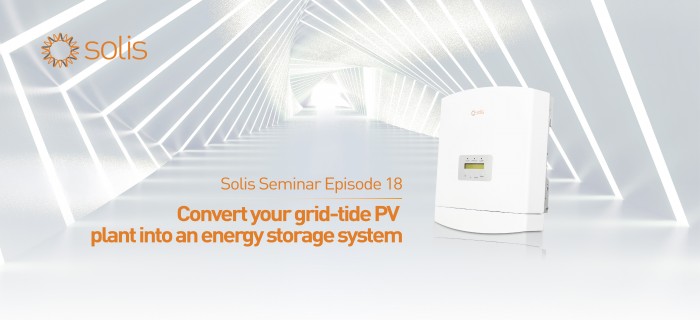
Solis Seminar, Episode 18: Upgrade a Grid-Tied Solar PV System to an Energy Storage System
21 Apr 2021
Background
In recent years residential energy storage systems have become more and more popular, especially in countries such as the United States, South Africa, Australia and across Europe.
The primary reasons for this are the following:
- Severe weather has led to tests of power grids across the world. We are experiencing exponentially more major power outages caused by ice storms, tornadoes, wildfires, hurricanes and flooding. These events like the Texas ice storm and storm Filomena in Spain can cause power outages for days leaving people to fend for themselves without water or electricity.
- High prices of electricity has become a major pain point for homeowners across the world. The world average energy price in 2020 was on average .113 Euros or .137 US dollars per kWh. Germany, for example, had the highest price of electricity at .304 Euros per kWh. The cost of electricity in almost all European countries has continued to rise over the past 10 years.
- The cost reduction of solar energy storage systems and policy support from forward thinking governments make the upfront cost more palatable and reduces the payback period for the average homeowner. Government programs such as Australia energy storage subsidy reduces a 10kWh energy storage system by 5000 Australian dollars.
Based on these primary reasons, homeowners are quickly realizing the benefit of a home energy storage system. For new systems, the obvious choice is to install a hybrid inverter that takes inputs from both solar PV and batteries. For someone who already owns a grid tied solar system, then upgrading and adding an AC coupled battery inverter (such as the Solis RAI) is a simple and cost effective way to obtain an energy storage solution. With just a few additional pieces of equipment alongside an AC coupled inverter, upgrading an existing solar PV system to include storage couldn’t be simpler.
Required Equipment – Solis RAI example
|
Equipment |
Specification |
Quantity |
Image |
|
RAI-3K-48ES-5G |
3kW |
1 pcs |
|
|
Battery Cables |
10mm2 |
+/- : 2m |
|
|
AC Breaker |
2P 20A |
1 pcs |
|
|
Batteries |
48V Li-ion/Lead-acid 50-2000 Ah |
Variable |
|
System Topology
When upgrading the grid-tied system to an energy storage system the only part that changes is the AC Coupled battery inverter add-on. The existing solar PV system doesn’t need to change at all. The AC coupled battery inverter is installed alongside batteries which is then connected directly to your panel or mains. If the customer wants critical load backup, then those loads will be moved to the backup port of the RAI. This will give customers the opportunity to select loads that they define as “critical”. Critical loads will remain online during a grid failure until the solar PV generation is null and/or the battery state of charge is null. Examples of critical loads would be refrigerators, hot water tanks, emergency lighting, etc.
|
|
|
Figure1 -AC coupled solution for single-phase power grid with 3kW & (3~10) kWh |
In the next Solis Seminar issue we will detail the installation process or you can visit the Solis website: https://www.solisinverters.com to find out more about the Solis AC coupled inverter such as, datasheet, compatible battery list and user manual.
Benefits of Expanding into Solar PV Energy Storage Systems
1). Use energy storage devices to adjust the peak and valley power demand of the grid and enhance the capacity of photovoltaic energy absorption.
|
|
|
Figure 2-The influence of energy storage on power grid regulation
|
2). Improve power reliability and power quality of clean energy.
|
|
|
Figure 3-Energy storage improves power quality
|
3). Improve self-consumption ratio and reduce electricity bills.
|
|
|
Figure 4-Energy storage improves self-consumption rate |
4). Enable emergency power supply in case of a grid failure.
|
|
|
Figure 5-Energy storage reduces the risk of grid failure |
Economic Benefits
Solar energy storage systems can reduce the cost of electricity and improve the stability of the homeowner’s power supply. Moreover, the cost recovery period is shortened and even more so if a local government subsidy is exercised. On average the cost recovery period of a grid tied inverter is 5 years globally but based on subsidies it can be increased or decreased. However if the AC coupled extended energy storage system is added, the recovery time is shortened delivering a more attractive option for all homeowners. All while accelerating the world’s journey towards a more sustainable future.
Conclusion
For homeowners who already have a solar PV system installed there has never been a better time to upgrade that system to an energy storage solution. With an AC coupled RAI battery inverter solution from Solis this transition is simple, cost effective and delivers energy security and peace of mind. Whether it is a simple grid failure due to localized works or a major weather system causing power failure, Solis will provide peace of mind to ensure homeowners critical loads remain connected and online.


leave your comment